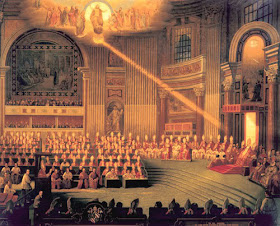While Vatican II is rightly described as revolutionary, scholar Russell Hittinger (University of Tulsa) and writer John O’Malley (What Happened at Vatican II) reveal the far more radical character of the First Vatican Council and the effect it had on the relationship between church and state.
Although most people are under the impression that Vatican II gave more power to the laity, O’Malley reminds us that the laity “enjoyed their strongest position in the first eight councils” of the Church. It was Constantine who called the Council of Nicaea, declaring himself an “external bishop” who claimed the authority to govern the temporal affairs of both the state and the church (e.g. leadership over councils, appointment of bishops, etc). At the Council of Chalcedon, nineteen imperial envoys were given special status, seated on an elevated platform at the center of the gathering. Lay involvement was not limited only to emperors and envoys: it was a Byzantine empress who convoked the Second Council of Nicaea in 787.
As the locations of ecumenical councils shifted from east to west, lay involvement in conciliar affairs continued. King Philip IV, for example, dominated the Council of Vienne, while in the latter middle ages professional lay theologians were sometimes allowed to vote during the councils themselves. These laymen were even given their own congregation at the Council of Trent – the final council prior to the twin Vatican Councils.
Three hundred and seven years passed between the conclusion of the Council of Trent in 1563 and the short-lived First Vatican Council of 1870. During this time, the Church experienced the traumatic wars following the Reformation, the rise of the nation states, the Enlightenment’s darkness, the brutality of the French Revolution, the atheist reign of Napoleon, and the end of both the Holy Roman Empire and the Papal States – which were replaced respectively by the newly unified nations of Germany and Italy.
The rule of the old kings and emperors of Europe, who saw themselves as “external bishops” in the mold of Constantine, was succeeded by the rising nation states. This ultimately forced the Church to make a very difficult choice: maintain the last vestiges of Christendom by allowing new governing bodies to inherit the ecclesial authority of deposed Catholic kings, or, at great risk, declare Christendom dead, thus severing all ties between church and state. The decision to follow the latter course is the reason Hittinger declares that Vatican I “is really the radical council, not Vatican II.”
In 1870, it was the Catholic Church – not a government shaped by the Enlightenment – that finally imposed the separation of church and state.
The writing was on the wall before the council even began. O’Malley states that when the council was called, “Catholic monarchs were urged to promote the success of the council, [but] they were not invited to attend or participate, and no lay person of any status took an active part in the council.” This act was a first step towards what Hittinger bluntly calls “a writ of divorce” between church and state. In response, three countries threatened to send troops to break up the council – but it continued nonetheless.
Besides defining the more well-known Dogma of Papal Infallibility, Vatican I declared the universal jurisdiction the Holy See, doing so precisely because it declared independence from the temporal affairs of the state. Thus the Church freely gave up any ambitions of temporal power and in turn declared her universal spiritual power as the Church amidst the nations.
Christendom was dead, and the Catholic Church killed it.
Retribution, of course, was swift. Only Belgium and Ireland approved of the council’s teaching. Meanwhile the larger nations of France and Germany confiscated church property and imprisoned half of the Church’s clergy respectively. But the Church was free in a way she hadn’t been since Constantine’s Edict of Milan in 313. O’Malley writes that the fruits of the council included the resurgence of religious orders, increased missionary activity, and the best-catechized laity in Church history.
To learn more on how Vatican II picked up where Vatican I left off, check out John O’Malley’s book, and Dr. Russell Hittinger’s Lumen Christi Institute talk, on Vatican II.

This comment has been removed by the author.
ReplyDelete